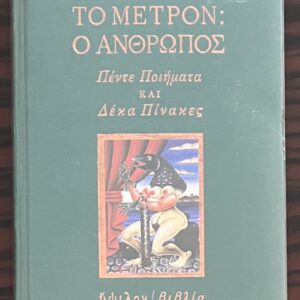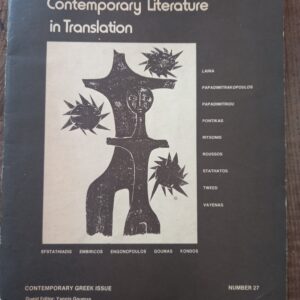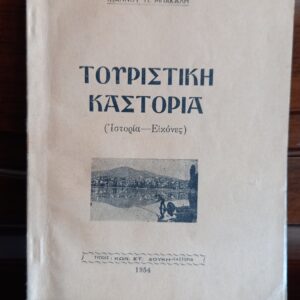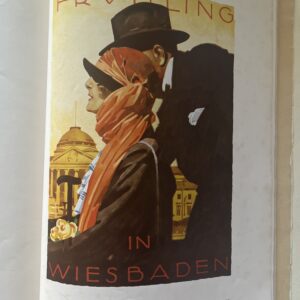1948-49, Rare, Issue I and II, Mansions of Kastoria, Houses of Zagora, Greece, First Edition, Nikos Engonopoulos
450.00€
Description
Πινακοθήκη της τέχνης του ελληνικού λαού
Α. Αρχιτεκτονική των Κοσμικών Μνημείων
Τεύχος 1
Αρχοντικά της Καστοριάς
40 Πίνακες
με φωτογραφίες του Λέων Φραντζή και Αντωνίου Οικονομίδη
και
αρχιτεκτονικά σχέδια των σπιτιών
Αθήναι 1948
Τεύχος 2
Σπίτια της Ζαγοράς (Πηλίου)
85 Πίνακες
με φωτογραφίες
και
σχέδια (μεταξύ άλλων) του Κλάους Φρισλάντερ
Αθήναι 1949
Χορηγία Εθνικού Ιδρύματος
Εκδόσεις Συλλόγου Ελληνική Λαική Τέχνη
Κάθε τεύχος περιέχει από ένα έγχρωμο σχέδιο του Νίκου Εγγονόπουλου
Τεύχος 1: Σπίτι Πηχεών
Τεύχος 2: Το Σχολειό του Ρήγα
Gallery of the Art of the Greek People
A. Architecture of Secular Monuments
Issue I:
Mansions of Kastoria
40 tables
with photos by Leon Frantzis and Antonios Oikonomidis
and architectural drawings of the mansions
Issue II:
Houses of Zagora (Pilio)
85 tables
with photos and drawings (among others) by Klaus Frieslander
Publications of the Hellenic Folk Art Association
Each issue contains a color drawing of Nikos Engonopoulos
Issue I: House Picheon
Issue II: The School of Rigas
40 cm x 32 cm
Original Card board Binding (Folder)
Tome Ι: 236 loose double and single-page spreads
including 85 full-page drawings and photographs
and
Tome II: 102 loose double and single-page spreads
including 40 full-page drawings and photographs
First Edition
Nikos Engonopoulos (Greek: Νίκος Εγγονόπουλος; 1907 – 1985) was a Greek painter and poet. He is one of the most important members of the Generation of the ’30s, as well as a major representative of the surrealist movement in Greece. His work as a writer also includes critique and essays.
The German Painter Klaus Frieslander (1909 – 1944) was the first teacher of Panayiotis Tetsis, one of the most important Greek painters, an exponent of the post-impressionistic seascape tradition.
Kastoria is a city in northern Greece in the region of Western Macedonia. It is the capital of Kastoria regional unit, in the geographic region of Macedonia. It is situated on a promontory on the western shore of Lake Orestiada, in a valley surrounded by limestone mountains. The town is known for its many Byzantine churches, Byzantine and Ottoman-era domestic architecture, its lake and its fur clothing industry.
Zagora is a village on the Pelion peninsula in Magnesia, Thessaly. During the Ottoman occupation, the area was given privileges during the reign of Sultan Mehmet IV, the most important of which was that Turks should not live permanently in the area. Agriculture and trade flourished, while local handicrafts of woolen fabrics and silk flourished until the middle of the 19th century. Wealthy Zagorian merchants settled in many cities abroad. Those who remained in the village maintained branches and representatives in important trade centers of the time (in Moldavia, Russia, etc.). The financial strength and the constant communication with the outside created the ground for the intellectual development and prosperity of Zagora.
Additional information
| Languages | Greek |
|---|
You may also like…
-

1948, Kastoria, First Athletic Games in Western Macedonia, Greece, Photos, First Edition
50.00€ Add to cart -

1983, Nikos Engonopoulos, Cataloque, National Gallery, Soutzos Museum, Athens
49.00€ Add to cart -

1933, Klaus Frieslander, Dovecotes of Mykonos, First Edition, Peristerones tis Mykonou
100.00€ Add to cart -

1983, Nikos Engonopoulos, To Metron o Anthropos, Ypsilon, Poems, NF, First Edition
49.00€ Add to cart -

1977, Contemporary Literature in Translation, Andreas Embirikos, Nikos Engonopoulos, Vasso Katraki
90.00€ Add to cart -

1954, Tourist Guide of Kastoria, Macedonia, Greece, First Edition, History and Photos
45.00€ Add to cart -

1987, Nikos Egonopoulos, Peza Keimena, Prose, First Edition
35.00€ Add to cart







































